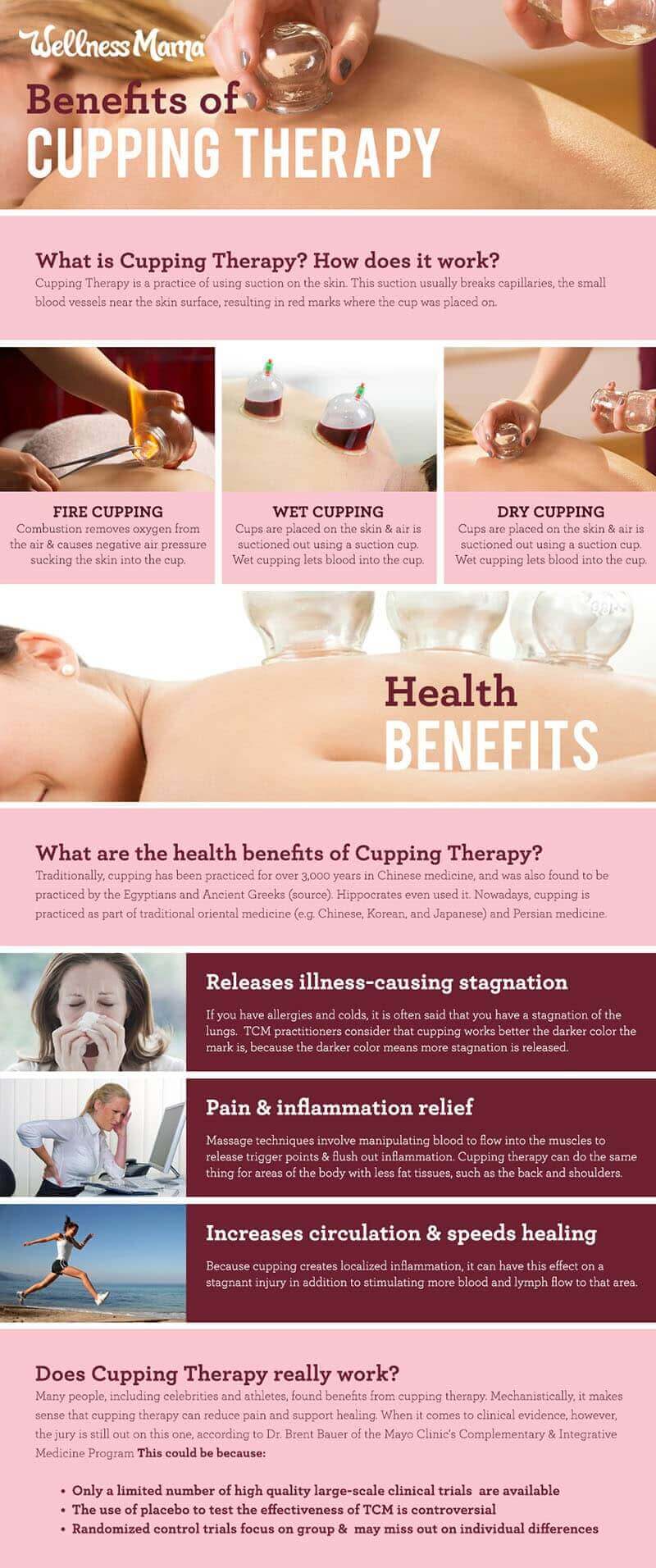

Many people got curious about cupping therapy after seeing the red round marks on Olympic athletes like Michael Phelps during the summer Olympics.
Cupping is essentially a form of body work or therapy that uses suction from the cups to achieve the desired results. This may stimulate blood flow, relieve pain, and provide many other health-promoting effects.
However, before going out and getting cupping therapy for yourself, it is a good idea to understand what it is, what it’s used for, and the potential pitfalls.
What Is Cupping Therapy?
Cupping therapy involves placing a plastic cup on the skin and pumping air out of the space inside the cup. This creates suction that breaks capillaries, the small blood vessels near the skin surface, and results in red (or purple) marks where the cup was. These were the circles seen on many athletes in the Olympics.
There are two types of cupping therapy: wet and dry. Dry therapy uses the action of the suction cup alone. Wet cupping (more commonly practiced in Persian medicine, called Hijama), involves bloodletting inside the suction cup.
Dry cupping can be done two ways:
- In a single area (also called static cupping)
- By moving the cup around to several places (more like a massage but with suction instead of pressure)
Origins of Cupping Therapy
Historical records document cupping use in Chinese medicine over 3,000 years ago. Other records indicate that the ancient Egyptians and Greeks practiced it as well. Hippocrates, known as the father of medicine, even used it. Nowadays, cupping is practiced as part of traditional Oriental medicine (Chinese, Korean, and Japanese) and Persian medicine.
Interestingly, the Chinese and the Egyptians both discovered cupping independently thousands of years ago? When the same healing tool is found in opposite parts of the world (before there was the internet, mind you) and the tool is still practiced thousands of years later, it is a testament to its benefits.
Traditional Chinese Medicine (TCM) historically placed cups on specific acupuncture points to stimulate the points. For example, someone with allergies and colds would be thought to have a stagnation of the lungs. In that case, a cup is placed on an acupuncture point for the lungs, and will often turn into the darkest color of bruises even though all the cups are placed on the skin with the same negative pressure. TCM practitioners consider that cupping works better the darker color the mark is, because the darker color means more stagnation is released.
Before there were plastic suction cups, practitioners used glass cups and flame (fire cupping). Burning a piece of cotton inside the cup removed oxygen from the air, causing negative air pressure. When the practitioner immediately put the cup on the skin, the skin underneath the cup would be sucked into the cup.
Modern Use of Cupping
While cupping is used in TCM for overall health, conventional physiotherapists use it too. Modern biomedical literature lists cupping as a pain-relief tool or as a tool for myofascial release. Many massage techniques involve manipulating blood to flow into the muscles to release trigger points and flush out inflammation. Similarly, cupping therapy can do the same thing for areas of the body with less fat tissue, such as the back and shoulders.
In a review article in the Journal of Bodywork and Movement Therapy, Rozenfeld and Kalichman (both academic physiotherapists) described the physiological effects of cupping:
“Mechanically, cupping increases blood circulation, whereas physiologically it activates the immune system and stimulates the mechanosensitive fibers, thus leading to reduction in pain.”
Sometimes a musculoskeletal issue that is stagnant in its healing process can be stimulated into healing by slightly irritating the tissue or initiating some inflammation. This concept applies to prolotherapy, where a foreign substance (usually dextrose) is injected into an injured joint to stimulate inflammation. Similarly, because cupping creates localized inflammation, it can have this effect on a stagnant injury in addition to stimulating more blood and lymph flow to that area.
Does Cupping Therapy Really Work?
Many people, including celebrities and athletes, attest to the benefits of cupping therapy. Mechanistically, it makes sense that cupping therapy can reduce pain and support healing.
When it comes to clinical evidence, however, the jury is still out, according to Dr. Brent Bauer of the Mayo Clinic’s Complementary and Integrative Medicine Program (source). This could be for a few reasons:
1. A limited number of high quality large-scale clinical trials
Presently, the clinical evidences supporting the effectiveness of cupping for low back pain and neck pain are promising. The medical world feels they need more rigorous clinical evidence before they can conclude that it really works.
2. Placebo effect
When medications are tested, it is usually tested against a placebo—a sugar pill dressed up as the medication. This ensures the effectiveness of the medications is truly because of the medications and not because the patient thinks they have taken the medication. Placebo effect can account up to 30% of the results in medicine. For this reason, scientists believe it best to compare any treatment against a placebo rather than a no-treatment group.
The use of placebo to test the effectiveness of TCM itself is controversial. First, it’s hard to come up with a physical placebo for acupuncture or cupping therapy that can isolate the belief that you’ve had the treatment from the treatment itself. Second, TCM is a mind-body medicine approach rather than just the body, so we can’t truly isolate the mental from the physical healing with TCM.
3. Average vs. Individual
Because randomized control trials look at people collectively as a group they may miss out on individual differences. Back pain, for instance, could result from a myriad of causes, such as sciatica, herniated disks, tight back muscles, SI joint disorders, or simply poor posture. Cupping therapy may be more effective against some of these causes and not others. In order to know for sure more thorough clinical study is necessary.
In real life, a clinician—be it a doctor, physiotherapist, or TCM practitioner—should be able to help identify causes health issues and treat with an individualized approach. Personal experience and a clinician’s expertise should help decide whether cupping therapy is right for you.
Managing the Risks of Cupping Therapy
Risks of injuries from cupping include:
- Muscle sprains or deep bruises from very heavy suction
- Burns from fire cupping (only get fire cupping from well trained practitioner)
- Infections from dirty cups
In order to safely and effectively receive cupping therapy, be sure to:
- Receive cupping therapy from qualified practitioner such as a TCM practitioner or acupuncturist. If you are receiving cupping therapy for myofascial work, consult your physiotherapist, massage therapist, or chiropractor for the best way to go about it and specific contraindications that you should be aware of.
- Pay attention to the pain levels and communicate with your practitioner as you are receiving cupping so they can remove the cups or adjust the pressure. It can feel uncomfortable to have suction cups on your skin, but the pain should not exceed a 2 out of 10.
- Only receive cupping therapy from hygienic clinics that sterilize their tools, and clean their cups between patients.
- Avoid cupping around areas with small, sensitive muscles and nerves. This includes the neck and jaws.
- Don’t try cupping near open wounds and fresh injuries.
- Avoid cupping if you are on a blood thinning medication or have a bleeding disorder.
- Avoiding leaving cups on for more than 15 minutes as the risks may exceed the benefits by this point.
- Always check with your primary doctor and any other necessary health professionals before beginning any type of therapy, including cupping.
Have you tried cupping therapy? What was your experience? Please weigh in.

Continue Reading...What Is Cupping Therapy? (Or Why Athletes Have Red Spots)
from Blog – Wellness Mama® https://wellnessmama.com/129773/cupping-therapy/?utm_source=rss&utm_medium=rss&utm_campaign=cupping-therapy
via SEO Derby
No comments:
Post a Comment